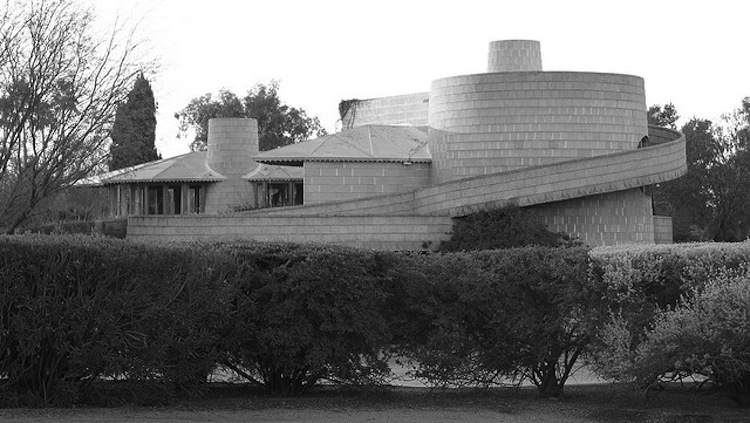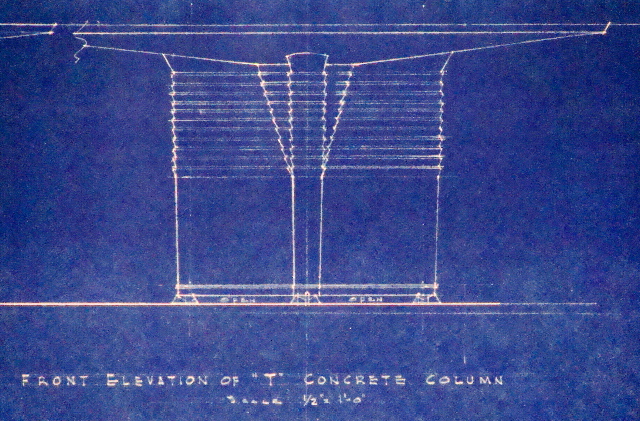Tweet The decision to initiate a historic overlay and landmark designation process for the David Wright House at the Planning Commission meeting on Tuesday June 12 came surprisingly quickly. Only Zoning Attorney and former Phoenix Historic Preservation Commissioner Grady Gammage spoke, though many others had prepared remarks in support of the motion to help save the historic landmark from possible demolition. Among the attendees and those who had prepared to speak were some heavy hitters on the local architecture scene including Eddie Jones, Wendell Burnette, Phil Weddle, Jack Black, and Matthew Salenger. Gammage spoke eloquently, emphasizing that the Commission wasn’t…
Posts Tagged ‘frank lloyd wright’
Tweet Today’s post is by contributing writer Jennifer Gunther. *Don’t miss the panel discussion tomorrow, March 28, as part of Modern Phoenix week, at the Phoenix Art Museum called Perspectives on Frank Lloyd Wright with panelists Grady Gammage, Emily Talen, Vernon Swaback, David Davis and Eric Anderson.* About one month remains for Phoenix Art Museum visitors to admire and explore the work of American architecture legend Frank Lloyd Wright. “Frank Lloyd Wright: Organic Architecture for the 21st Century” will be on view until April 29. The name Frank Lloyd Wright appears everywhere in Phoenix. The name of the Wisconsin-native designer…
Tweet This week I am posting Will Bruder’s excellent essay for the 98th Arizona Town Hall meeting, “Capitalizing on Arizona’s Arts and Culture”. I’ll be posting the essay in 3 parts. In today’s post, which is the second part, Will gives an extraordinary account of the history of architecture in Arizona. If you missed part I, where Will defines architecture and the urban fabric, catch it here. If you’d like to read Will’s entire essay in one sitting, you can find it on the Arizona Town Hall report starting on page 76. Arizona’s architectural identity is built on a foundation…
Tweet Today’s post is by one of my favorite architects Eddie Jones. I heard Eddie speak at the Arizona Historic Preservation Conference a few weeks ago about a new direction he’s taking with design. Find out why Eddie is tired of shiny new buildings and is more intrigued with the effects of time on the built environment. Edward (Eddie) Jones, with his business partner and brother Neal, were raised in the oil fields of Oklahoma. From a very early age the two bothers aspired to be architects and share a studio. Eddie was born in 1949 Texas and moved to…
Tweet My husband Paul shook me awake the morning after I arrived in Milwaukee at 3am just 6 short hours before. Groggily I resisted being woken up, but he insisted. He said, “you’re going to want to see the Frank Lloyd Wright exhibition at the Milwaukee Art Museum”. Grudgingly I acquiesced and dragged my tired self out of bed. But once we pulled up to the museum, my face brightened and I felt a rush of adrenaline. It was a dark, rainy spring day in Milwaukee, but the museum addition jutting out onto Lake Michigan by Santiago Calatrava looked stunning…
Tweet On the 24th of March, I spoke with Architekton principal, John Kane at his fabulous Downtown Tempe office. Below is part I of our conversation: The architect who’s influenced John most: “In the early days, Zaha Hadid was one of my heroes. She still is one of my heroes. But I think she’s the one, when I was in school, the profession was going one way and she kind of shook it all up. I think I’ve always admired that kind of panache and the excitement in the way she works and the art of the whole thing.” His…
Tweet On the 24th of March, I spoke with Architekton principal, John Kane at his fabulous Downtown Tempe office. Below is part I of our conversation: The architect who’s influenced John most: “In the early days, Zaha Hadid was one of my heroes. She still is one of my heroes. But I think she’s the one, when I was in school, the profession was going one way and she kind of shook it all up. I think I’ve always admired that kind of panache and the excitement in the way she works and the art of the whole thing.” His…
Tweet Last week I had the honor of interviewing one of my all-time favorite architects in the Valley, one of my heroes, Eddie Jones. Below are video segments of the first half of our interview. I hope you’ll be as inspired and thrilled as I was when you watch. Part I: Architects that have had the most influence on Eddie: Part II: Eddie on how his work responds to the local context and what sustainability means to him: Stay tuned for the second half of my interview with Eddie tomorrow!
Tweet Eric Corey Freed, licensed architect, LEED ap practices a very special brand of architecture called organic architecture out of his firm organicarchitect in San Francisco. Early in his career, Eric studied under an apprentice of Frank Lloyd Wright, gaining an appreciation for and adopting Wright’s philosophy of organic design. In his own practice, he has also become deeply involved in ecological and environmentally responsible architecture drawing from ancient design principles and new technological innovations. He has co-developed the Sustainability Programs at the Academy of Art University and the University of California Berkeley Extension. Eric is the author of four…
Tweet “Beginning in the early 1930’s, Chicago architects Fred and William Keck began a decade-long investigation of south-facing windows in residences that became the first to be called ‘solar houses’. During this same period, two internationally reknowned modern architects, Walter Gropius and Marcel Breur, both applied climatic analysis as major design determinants, as evidenced by generous south-facing and properly shaded windows. Frank Lloyd Wright in his Usonian house designs in Wisconsin and simultaneously in his design of Taliesen West in Arizona, all executed in the late 1930s, ingeniously and appropriately applied climatic design elements to diverse and contrasting climates, giving…






















